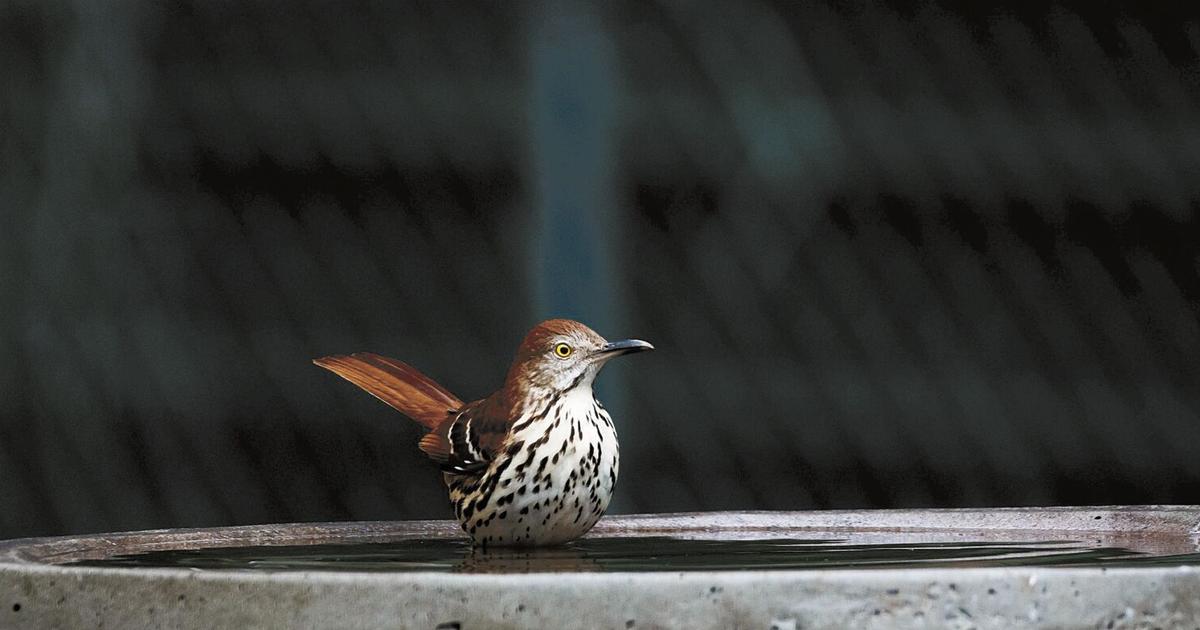
Just when it appears safe to welcome spring, nature throws a curveball in the form of a snowstorm and a frigid but brief cold snap.
At least the snowstorm had a silver lining at my home when a pair of brown thrashers chose to make their spring arrival at the same time.
Many of the resident birds looked a bit peeved to find snow and ice after a bout of mild spring weather, but the two thrashers outside my window on March 12 looked absolutely stunned.
I’ve always thought that brown thrashers are expressive birds, but the expressions of these birds looked like a mix of bewilderment and consternation to find that their return coincided with a short-lived dip into temperatures in the single digits.
Karen Fouts, who resides in Marion, Virginia, commiserated with the thrashers, agreeing with my post that the poor birds appeared stunned by the change in the weather.
“I’ve been waiting for ours but hope they wait a week or so,” Karen wrote in a comment to my post.
People are also reading…
Although a few brown thrashers linger in northeast Tennessee through the winter season, the majority of these birds fly a little farther south for the cold months. Invariably, brown thrashers make their return in March and can be considered another of our feathered friends whose arrival represents more evidence that spring is returning.
A few years ago, quite by accident, I came across a brown thrasher nest. I hadn’t gone looking for it. The nest, expertly woven into a thicket of honeysuckle vines, was tucked beneath a sheltering eave of an outdoor storage building. I don’t think anything but a fortunate accident could have ever revealed the nest. I still remember peeking into that tangle of vines and seeing a golden eye staring back. The bird didn’t look in the least pleased that I had accidentally stumbled across her nest.
The otherwise extroverted brown thrasher, which prefers to nest in difficult-to-access, tangled messes, found the cluster of vines a perfect location.
For those not familiar with brown thrashers — relatives of the Northern mockingbird — they are known for their feisty and fearless protection of their nest and young. I’m probably fortunate the thrasher on her nest decided to choose stealth instead of attack. Sometimes, discretion is truly the better part of valor and the bird probably decided that, if she remained motionless, she would blend in well with her surroundings.
The brown thrasher (Toxostoma rufum) belongs to the family of “mimic thrushes,” which provides a label for a group of songbirds capable of imitating the songs of other birds. Mimidae, the Latin root for “mimic,” provides the scientific name for the family, which includes mockingbirds and the New World catbirds, as well as thrashers. The Northern mockingbird is best known for the ability to mimic, but relatives like the gray catbird and brown thrasher are also talented mimics.
The thrasher is a fairly large songbird about 11.5 inches long with a wingspan of 13 inches. Much of the body length comes from the bird’s long tail feathers. A thrasher weighs, however, only about 2.5 ounces.
The brown thrasher is not a picky eater. It’s known to eat everything from berries and nuts to insects and small lizards. It’s also aggressive in defending its nest and young. John James Audubon, a French-American ornithologist, naturalist and painter, painted quite a dramatic scene of a group of brown thrashers valiantly defending a nest from an attacking snake. The painting is so detailed that one must imagine Audubon based his work on a real-life experience. His work, originally painted in the early decades of the 1800s, still holds up today.
Incidentally, Audubon knew the brown thrasher as the “ferruginous thrush.” Another former common name for this species was “brown thrush.”
They are familiar birds in southern gardens. In fact, the brown thrasher is the official state bird of Georgia and also provided the name for Atlanta’s National Hockey League team, the Atlanta Thrashers. The thrasher became Georgia’s state bird due to passage of a Joint Resolution of the Georgia General Assembly in 1970.
Returning to the expressive nature of brown thrashers, I think it’s the bird’s golden eyes that make them seem so alert and attentive. Once they feel secure in a lawn or garden, they become less shy. As one might expect from a large songbird, thrashers have voracious appetites. Among the feeder fare I offer, thrashers seem to prefer suet cakes. They’re not woodpeckers, however, so the awkward attempts of these long-tailed birds to access the suet offer some comic antics for observers.
More birds are due to make their spring returns soon. The return of ruby-throated hummingbirds is a highly anticipated arrival for many people. These birds usually get back in the first weeks of April. As always, I hope to track the return of these tiny flying gems.
To share your first spring hummingbird sighting, send me an email at ahoodedwarbler@aol.com or contact me on Facebook. Please provide the date, time and location for your sightings.
"bird" - Google News
March 30, 2022 at 01:52AM
https://ift.tt/awxyG8h
For the Birds: Brown thrashers return to rude, cold awakening - McDowell News
"bird" - Google News
https://ift.tt/i46wv5K
https://ift.tt/sihHVcO
Bagikan Berita Ini














0 Response to "For the Birds: Brown thrashers return to rude, cold awakening - McDowell News"
Post a Comment